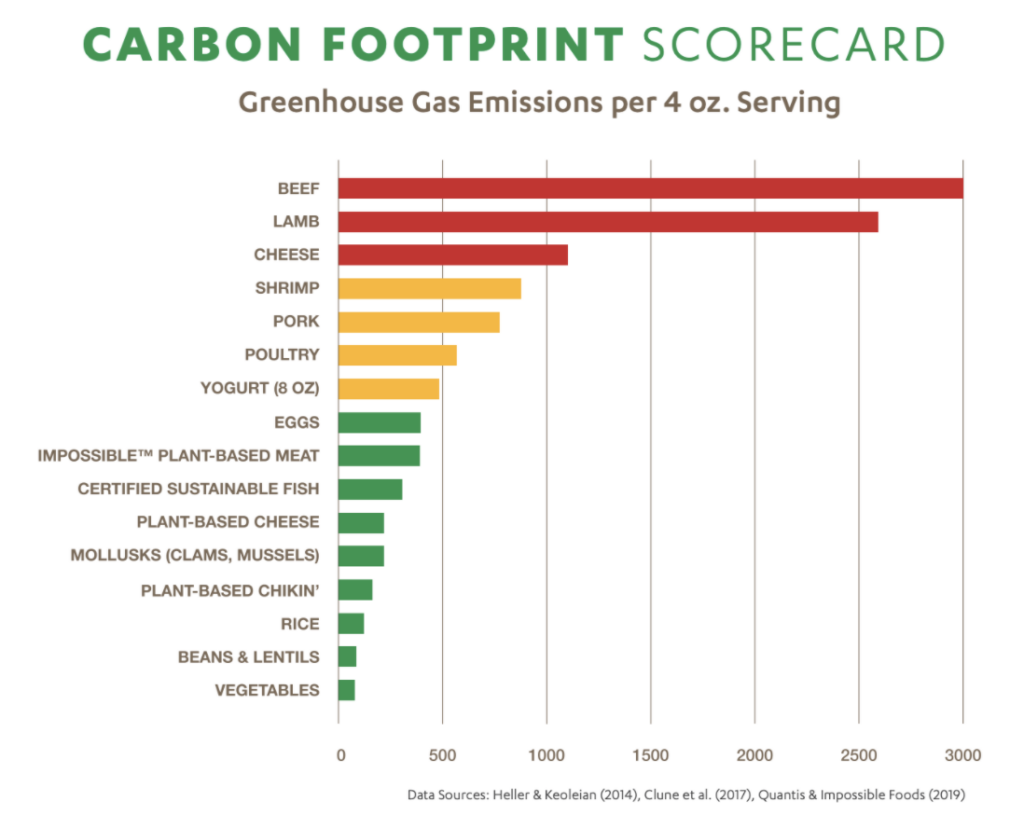What Does “Carbon Footprint” Mean?
Food production is responsible for roughly 25% of the world’s greenhouse gas emissions. (1)
Greenhouse gases are produced in the process of growing, rearing, farming, processing, and transporting the foods we eat. These greenhouse gases make up a food’s “carbon footprint” (2)
Different foods have different carbon footprints. Generally, animal-products have a higher footprint than plant-based products, as seen in the graph below Beef and lamb have by far the highest carbon footprint. (3)

Used with permission from UCLA Housing and UCLA Department of Community Health Sciences
Changing the foods you eat can have a big impact on your carbon footprint. Many of these changes will also be beneficial for your health! For example, shifting to a vegetarian meal one day a week for one year could save the equivalent of driving 1,160 miles. (4)
But you don’t have to be fully vegetarian or vegan to make an impact. By switching to less carbon-intensive animal sources (such as fish and chicken) you will go a long way to reducing your footprint. For example, replacing all beef consumption with chicken for one year would save the equivalent of driving 993 miles. (5)
Carbon Footprint Icons
If you want to reduce your impact on the environment and the climate, a helpful first step is to know which foods have the highest climate impact.
Look for these icons in our online menus. The green icon has the lowest climate impact and is usually the most plant-forward. The red icon has the highest impact, usually consisting of beef which emits a lot of greenhouse gases.
| Icon | Carbon footprint | Serving | Miles driven |
|---|---|---|---|
Green  |
Low (0–.29 kg. CO₂) |
1 | ~.5 |
Yellow  |
Medium (.3–1 kg. CO₂) |
1 | ~1.5 |
Red  |
High (1+ kg. CO₂) |
1 | ~3 |
From the above comparisons, we see that on average, dishes with the red icon can be 6 times more carbon-intensive than dishes with the green icon.
How was the carbon footprint calculated in the making of the icons?
We used the Cool Food calculator by the World Resources Institute which sourced its greenhouse gas emissions data from Poore and Nemecek (2018) and Searchinger et al. (2018). The data includes all upstream GHG emissions from agricultural supply chains (production, transport, processing, packaging, and food losses) except emissions associated with land-use change. We calculated carbon emissions for each ingredient used in Berkeley Dining’s recipes. Taking account of the portion size of each ingredient, in each recipe, our menu management system can now track the amount of carbon produced by each dish. We analyzed this data and set a threshold for the high, medium, and low emissions categories.
Berkeley Dining makes every effort to keep this data accurate. However, due to the volume of meals served and items used each day, carbon footprint data may not always be accurate or up to date. Email dining@berkeley.edu if you have any questions about a particular dish or the carbon footprint calculations.
Learn More About Your Food Carbon Footprint
BBC’s Food Carbon Footprint Calculator allows you to compare the carbon emissions of 34 different food items by choosing an item and indicating how often you eat it.
Sources
- “You want to reduce the carbon footprint of your food? Focus ….” https://ourworldindata.org/food-choice-vs-eating-local.
- “Carbon Footprint of Food | Green Eatz.” https://www.greeneatz.com/foods-carbon-footprint.html.
- “You want to reduce the carbon footprint of your food? Focus ….” https://ourworldindata.org/food-choice-vs-eating-local.
- “Carbon Footprint Factsheet | Center for Sustainable Systems.” http://css.umich.edu/factsheets/carbon-footprint-factsheet.
- “Carbon Footprint Factsheet | Center for Sustainable Systems.” http://css.umich.edu/factsheets/carbon-footprint-factsheet.